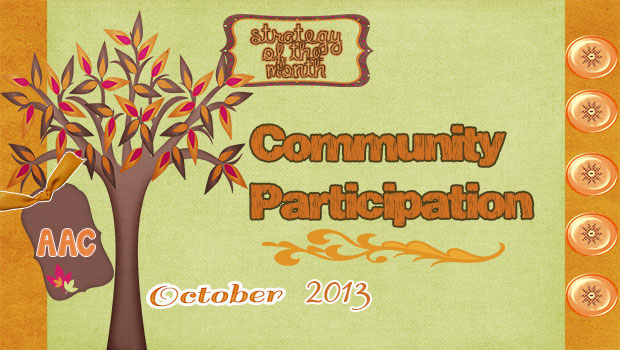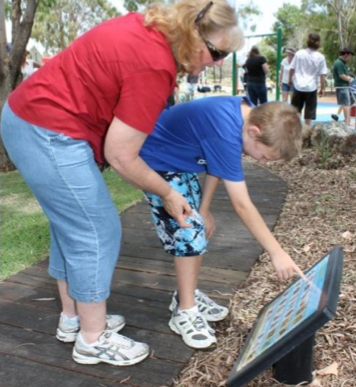Strategy of the Month: Community Participation

Community participation and communication for AAC users is an integral part of of developing, growing up, and having inclusive opportunities. We often relate community participation to quality of life indicators. Community participation for AAC users begins from the… beginning. Young children can order in restaurants, use picture menus, and have access to many inclusive events. As children grow into adolescents and adults, community participation involves post secondary options, employment, and community living.
Perspectives from AAC Users
- Have communication displays and devices available at ALL times– You need access to a communication system(s) to participate in all situations. Remember to take AAC with you. The sooner the AAC user becomes responsible for taking or telling someone to take the device/displays with them the easier it becomes. For mobile technology systems, there are rugged cases that withstand wind, water, even medical waste (see Lauren Enders Pinterest boards for case and accessory options). There are mounting systems, holders and straps for both traditional AAC devices and mobile technologies (have you seen chat bags or safe n sound mobile)? There are purses, totes, and fanny packs that all help make it easy to carry AAC displays with you. There is also laminate, binders and folders that support AAC on the go.
- Need features of display and devices matched to environment– As AAC systems are developed, there are important features for community participation that need to be considered. Considerations include features for face to face communication, distance communication, as well as training and support. For face to face communication, AAC users need quick access to core and fringe vocabulary. They may need multiple output options (voice output, print output, varied voices, and intensity levels). For full community participation in post secondary, employment, and living settings, feature considerations include multiple functions of the AAC device for email, note taking, and writing. Integrative tools within the AAC technology may also be needed and include calendars, contacts, etc.
- Interact with AAC Role Models– We all have people in our community that speak the same language as we do and AAC users want and need this as well. AAC users need to see AAC displays build into events and see other people using AAC devices in the community. By having AAC role models and mentors, we are more likely to see more comprehensive participation.
Perspectives from Community Partners
- May need encouragement, and positive experiences– Inclusion for everyone, at times can feel like a new concept. It may be the first time a community partner is making a special effort to including AAC users in their events or organizations. We want to provide support and encouragement to make events inclusive. By providing this, events tend to be successful and with that comes positive experiences. And even if the event needs modifications or changes in the future, it feels positive to talk it out and problem solve together. Most partners are not looking for perfection as much as they are looking for support. Reinforcement goes a long way for everyone.
- May need specific training– Community partners often need training on what to expect, what supports to put in place, what to do in an emergency or they might need some disability specific training. Who does this training?, it can be educators, resource groups, SLP’s, families, or AAC users themselves. It all depends on who is involved in creating the community event, employment, living arrangements, or post secondary options.
- May need help with materials and resources– When we work to support community participation, there are often professionals or parents helping out. As Carole said so eloquently last week in her post on School Participation, the professional or parent, is often a ‘guest’. Take this seriously and volunteer to support the community partner by creating and making materials, helping to ensure the AAC user has what they need, and even spreading the word about an event or group.
Perspective from SLP’s, Educators, & Families
- Create community partnerships– Sometimes community partners come to you to ask to create an inclusive event other times we seek out organizations, community businesses, colleges, and other places to host or support AAC users. Building partnerships can lead to long lasting opportunities for community participation. We have seen sports, concerts, museums,libraries, restaurants, colleges, and many more community opportunities be available to ALL people. We continue to see job options grow (although maybe not fast enough) for AAC users.
- Develop AAC mentoring relationships– Take a look at some of the structured mentoring programs to help begin or participate in AAC mentoring in your community. Michael Williams from the Penn State Mentoring Project says “There is no limit to the kinds of things a person who relies on augmentative and alternative communication might want a mentor for: strategies for independent living, relationship development, employment issues, education issues, self-advocacy, personal assistant management, psychosocial issues, communication skill development, life goal planning. Each transition can be smoother with the help of a mentor.”
- Help develop community awareness and acceptance– This is the perfect month to help your community have AAC awareness & acceptance. The more information spread, the more events we have, the more opportunities AAC users will have in the community. Look to ISAAC for 2013 AAC awareness activities.
 Things to Do for a Community Events & Projects- We can incorporate AAC strategies into community events. Modeling good use of visual supports and AAC technologies helps AAC users as well as families, potential friends, and employers.
Things to Do for a Community Events & Projects- We can incorporate AAC strategies into community events. Modeling good use of visual supports and AAC technologies helps AAC users as well as families, potential friends, and employers.
- Develop social narratives– you can send the link to the social narrative with confirmation or have a link to the social narrative on your website (Dan Marino WalkAbout Play Book).
- Develop schedules, mini schedules, calendars
- Develop choice boards for your events– You can food choice boards/menus with pictures and text, picture symbol activity choice boards. You can even add some group communication boards in an area like the Queensland Project did for parks and play.
- Provide trainings for volunteers

Communities and People Making it Work (just a few)
Chris Klein Builds Participation by AAC-RERC
UM-NSU Center for Autism and Related Disabilities
Some references
Batorowicz, B., McDougall, S., & Shepherd, T. (2006). AAC and community partnerships: the participation path to community inclusion. AAC: Augmentative & Alternative Communication, 22(3), 178-195.
Mcnaughton, D., & Bryen, D. (2007). AAC technologies to enhance participation and access to meaningful societal roles for adolescents and adults with developmental disabilities who require AAC. AAC: Augmentative & Alternative Communication, 23(3), 217-229.
Filed under: Strategy of the Month
This post was written by Robin Parker
